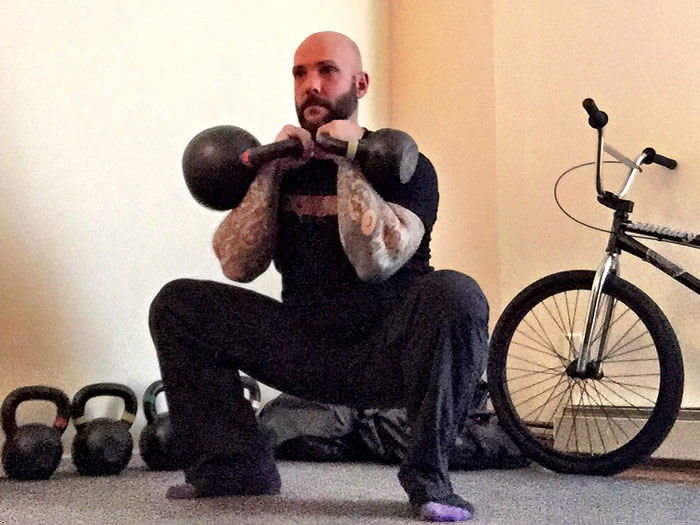Which Is The Best Squat?
2019-01-18
It is probably the best feeling in fitness. No, it isn’t hitting a personal record, losing that last stubborn 10 pounds, or things like that. The best feeling is not feeling like a prisoner to what others feel like you should be doing in your training and what better example than how so many look at the squat!
I recently heard a well respected fitness pro discuss that so many people default to the barbell back squat because that has long been the “right of passage” for people in the gym. It never dawned on me that this was the perception, but he is right! Heck, I know I did it and was embarrassed that I couldn’t do a good squat for years!
Working A LOT on issues from my ankles and feet (from over a decade of competitive basketball) allowed me to finally hit a back squat that just didn’t destroy my body. As I got into competitive Strongman, everyone believed heavy deadlifts and back squats were the key to being successful at the implements like tire flips, stone lifting, and all those crazy things!
There was a major problem though, since 14 my back had been severely injured. While I could deadlift well and had a decent back squat, once I got to really heavy levels, my low back and hips started to hate me BIG time!

Using these DVRT squat strategies is how I reclaimed my movement after spinal surgery in almost record time!
Sure, there will be those that suggest, “Josh, you just need to learn to squat well!” Well, I had learned squatting from some of the top strength coaches in the industry as well as a World’s Strongest Man competitor. So, I’ve heard and tried so many of the styles and methods to squat well.
What I found out over time, for a variety of reasons, my body wasn’t built for heavy barbell back squat workouts. My bone structure isn’t like some of those coaches whose forearms were as big as my calves. I had a basketball players frame and shockingly, most basketball players don’t love back squats.
Okay, that’s fine, I’m a sample of one and who cares about basketball players? Well, what happened to me is that I started to search for other ways to train my squat in a way that did help and not hurt me. My first love became kettlebell front squats. Even though I had done the barbell front squat many times, the kettlebells were even friendlier because the load helped me brace my core more and the load in front of the body in that manner kept me more upright.

While I felt better with kettlebell front squats, I started to see what else would make me have a similar feeling. What I started to see in myself and my clients was that the more tension they could create in the core, the better their squat because. This is is a concept that Powerlifters teach, but for many of us, it is hard to do really well without additional feedback (not to mention many Powerlifters have tough times with hips and low backs even WITH this concepts).
This idea made me start to play with using the Ultimate Sandbag in different ways to create tension and feedback for the body. All of a sudden, I started finding myself and clients squatting deeper, while still challenging ourselves, but here is the one thing…..we didn’t hurt after!

Teaching the U.S. Marines how to move better and be strong was a key goal we were given. Sharing these DVRT Squat techniques as a big part.
I know, I know, “Josh, if you are going to be strong, you HAVE to get under the iron!” This is what I am talking about, this was the same belief I had and time and time again my body felt crappy afterwards. I kept doing it because all my career and in everything I was taught, you had to barbell back squat if you were going to be a serious coach and strong! Then I did something I never thought I would!
I said forget it! My workouts were the poster child for the definition of insanity. If I did some of the Ultimate Sandbag squats that I am going to show you, I felt good, my clients felt good. When we did barbell back squats, no one felt that great.
What about getting strong? Am I just selling you this crazy idea so you use Ultimate Sandbags for your squat? Let’s look at a bit of science.

A 2009 study by Gullet et. al, found, “The front squat was as effective as the back squat in terms of overall muscle recruitment, with significantly less compressive forces and extensor moments. The results suggest that front squats may be advantageous compared with back squats for individuals with knee problems such as meniscus tears, and for long-term joint health.”
Eh, one study right? Well, how about the additional fact the front squat was 44 pounds less than the back squat? Yea, but still one study!

A study be Dewey et al. found something even more shocking! Comparing back squats to bodyweight lunges, the researchers found, “The results demonstrated that there was no greater muscle activation when performing any of the squat depths to that of the body weight lunge. It was revealed that the body weight lunge did indeed produce more activation in the majority of all muscles analyzed when compared to the three squat depths……By training the athletes in the body weight lunge, they can obtain the same results of that of squat to 90̊ training. The lunge allows the athlete to be in a more sport functional position. From the basic lunge position of the knees flexed to 90̊ we can begin to train explosive recovery moves, which would transfer over to competition. Ideally, athletes should be training their kinetic chain fluidly and dynamically; the more dynamic the activity the more fluid the athlete’s movement and posture will be in competition. As a coach, personal trainer or athletic trainer, we should begin to worry when movement gets ridged because of the susceptibility to injury.”
So, this idea that we have to back squat to get strong is just a gym myth. Renowned Strength Coach, Mike Boyle, once said, “you know who is the strongest proponents of you have to back squat? Those that are designed to back squat!”
Physical Therapist, Dan Swinscoe breaks down what makes the Bear Hug Squat so effective compared to other types of squats.
My question as someone that has people come to me for help in not just looking good, but feeling good too! So, how do we accomplish both? DVRT Master, Cory Cripe, shows some variations we have available to us in having variety to our squat, but also purpose!
Don’t miss saving 30% on our Ultimate Sandbags and DVRT Education with coupon code “summersault” HERE and check out our great DVRT online education including our NEW L.I.F.T. program HERE that features squatting techniques that make a REAL difference!
https://www.instagram.com/p/Bqsdb8ghvhu/
© 2026 Ultimate Sandbag Training. Site by Jennifer Web Design.







